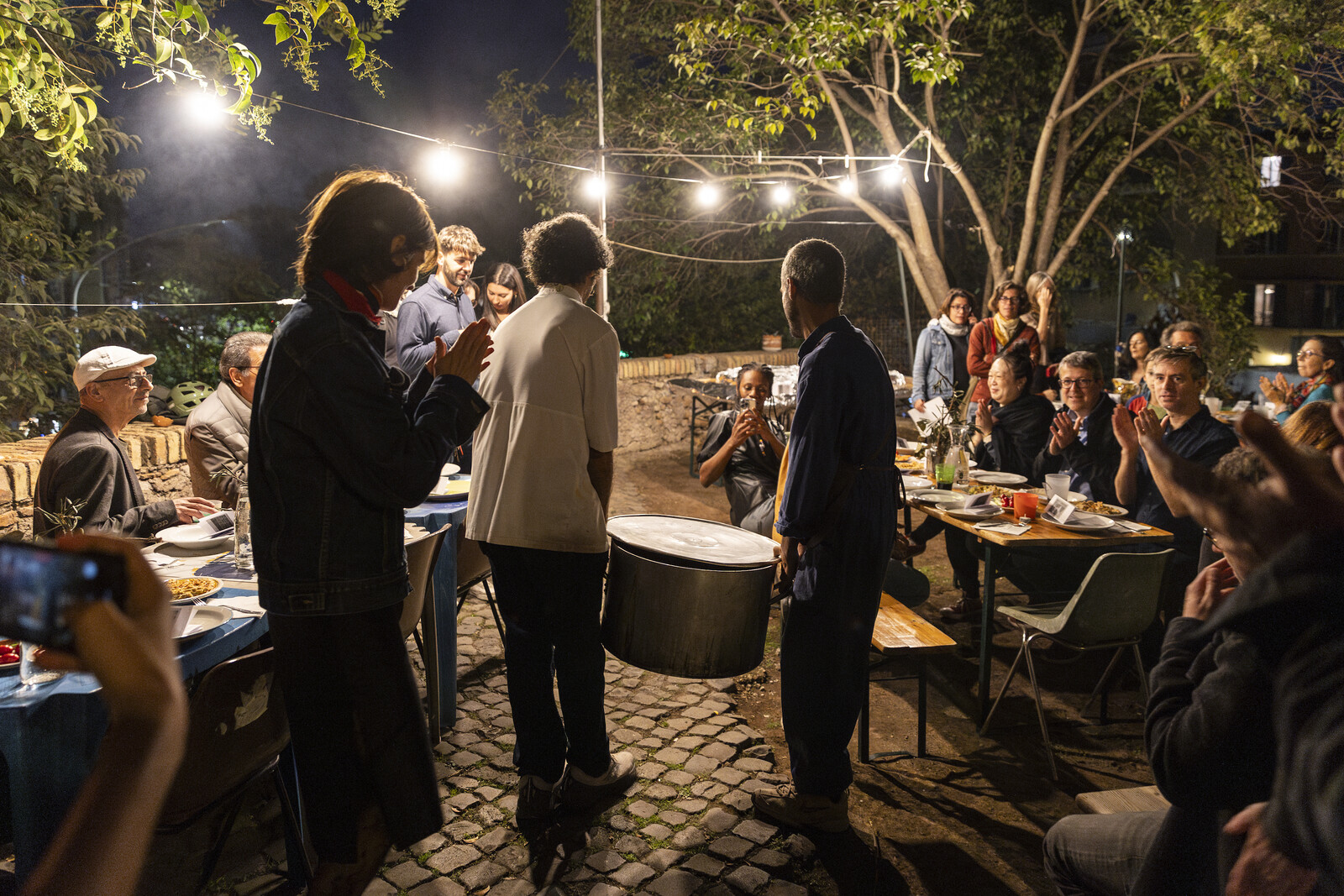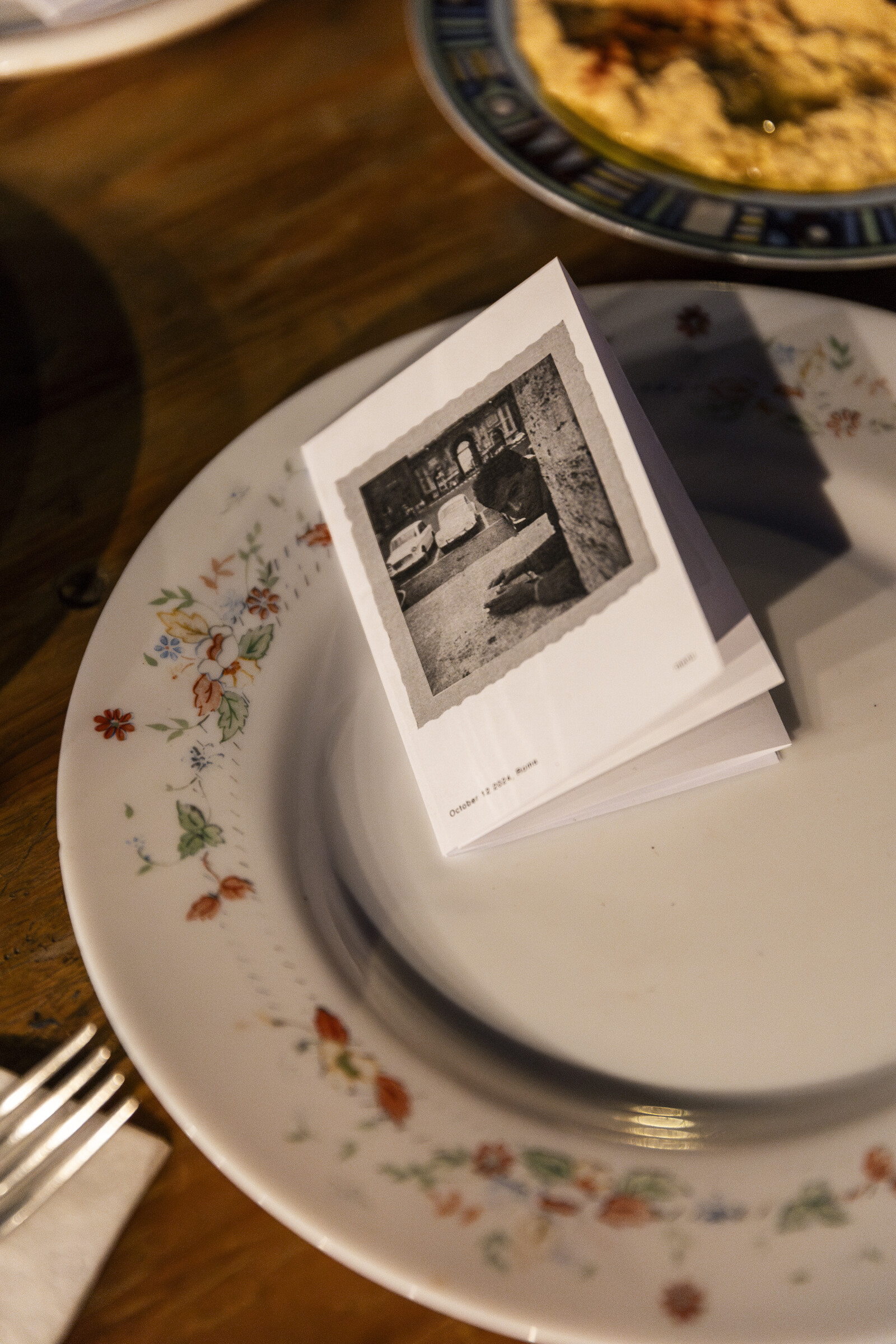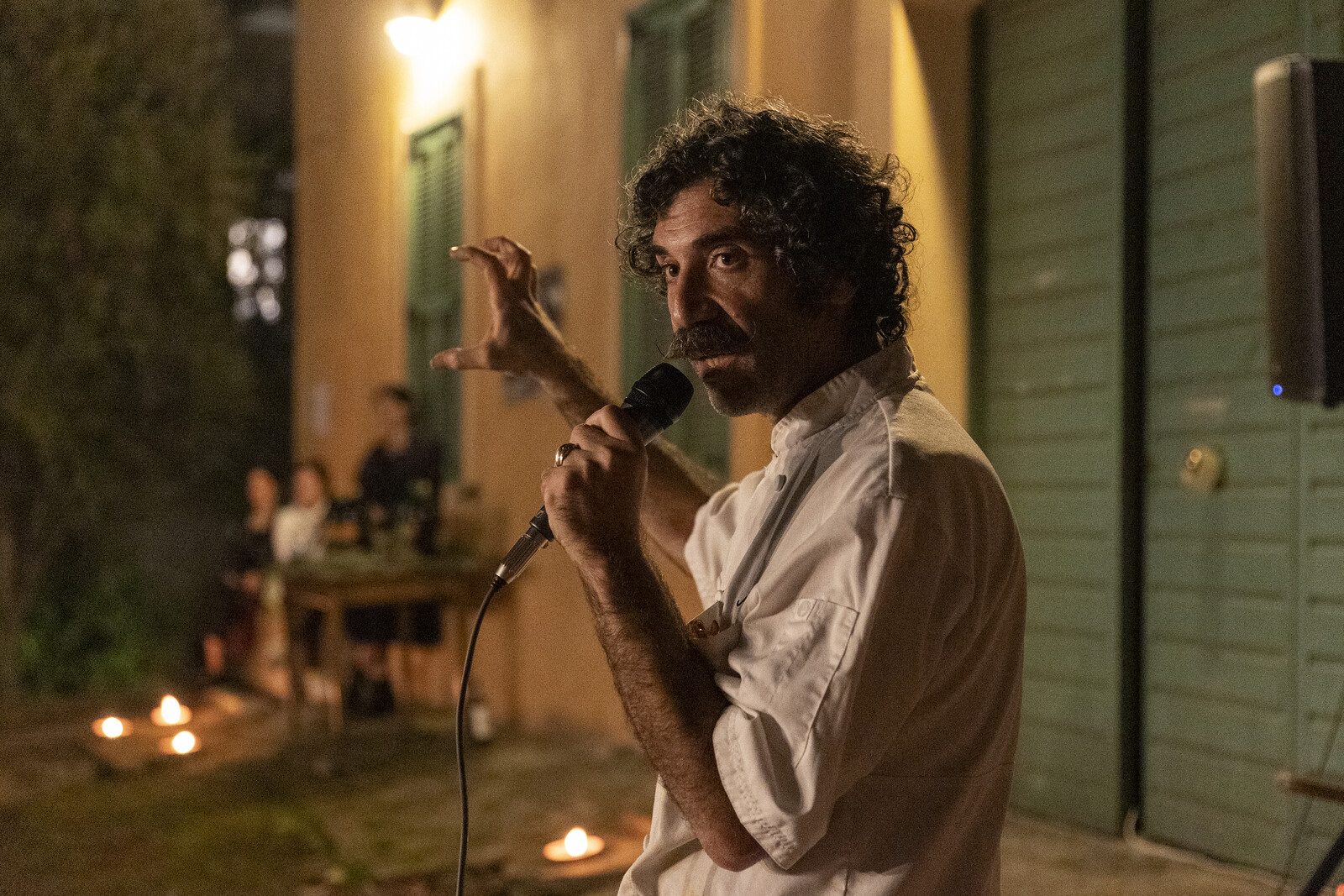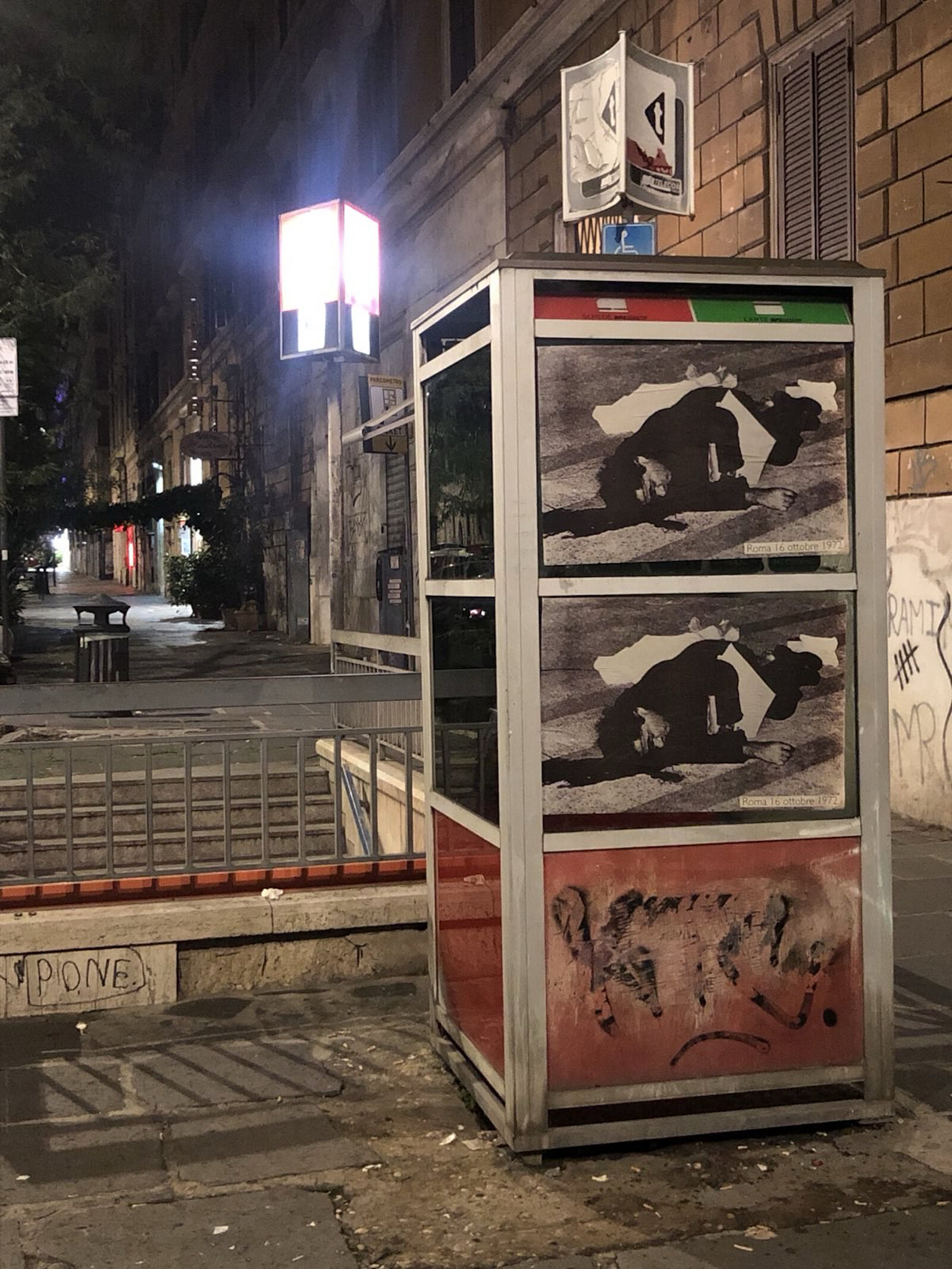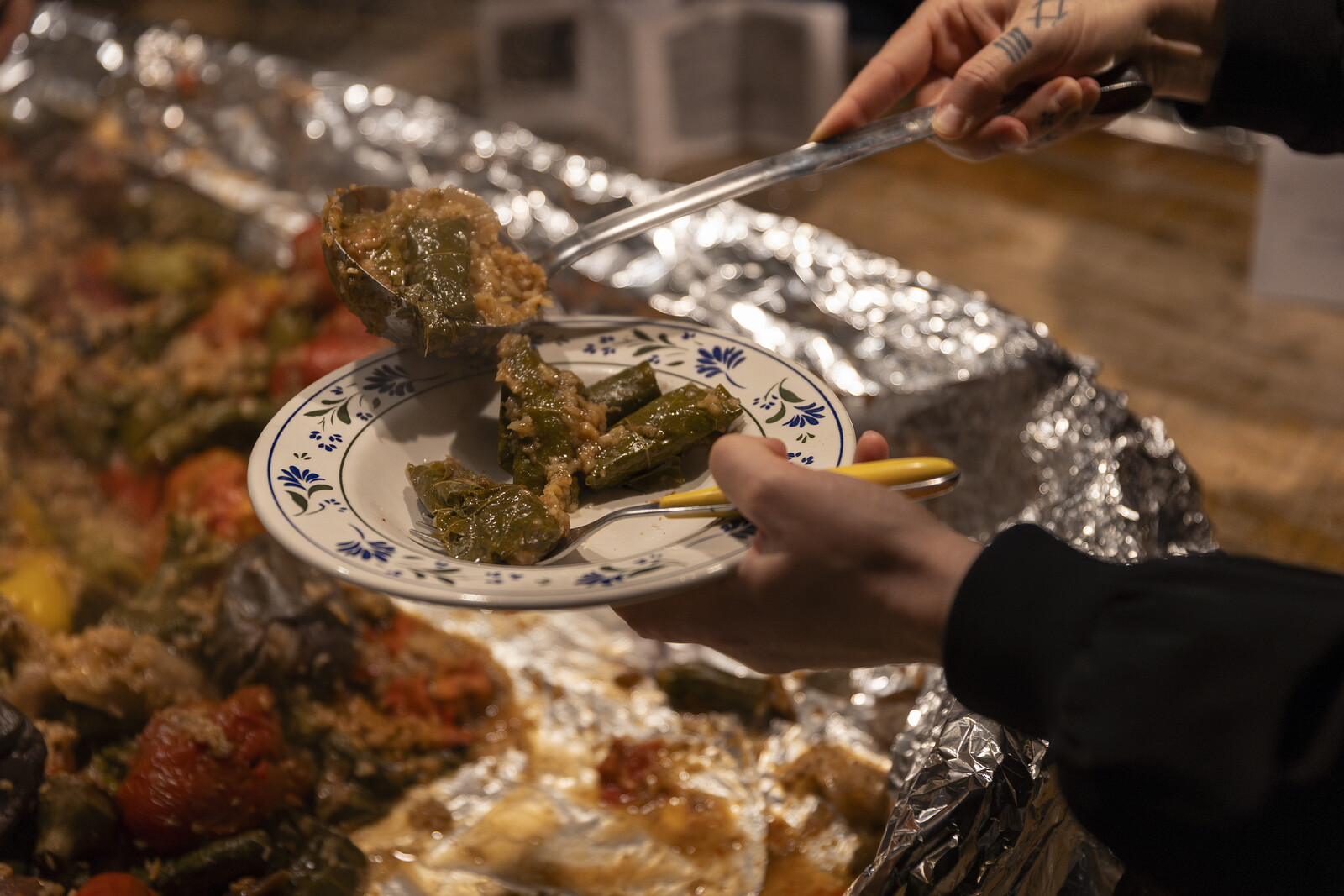In the San Paolo quarter of Rome, artists Emily Jacir and Michael Rakowitz staged a “performative” dinner to commemorate the life of Palestinian poet and translator Wael Zuaiter, executed by Mossad agents at his home in the city fifty-two years earlier. Organized by curatorial collective Locales, it was the final event in a public program focusing on the body as an artistic medium for learning and transformation. Nearly one hundred guests gathered at long tables on the terrace of Città dell’Utopia, an international social laboratory dedicated to communitarian activism located in an eighteenth-century farmhouse that was a trattoria and antifascist hub founded by Augusto Volpi in 1907 and later a refuge for resistance fighters during World War II. Now an anachronistic apparition surrounded by apartment blocks, it is still a welcoming, convivial hive.
The poignant title, evoking the far-reaching repercussions of every action, is taken from a poem by Francis Thompson that Zuaiter quoted in an article published in L’Espresso shortly before his assassination. Zuaiter was the first victim of the Israeli operation Wrath of God, ostensibly targeting those held responsible for the massacre carried out by Black September at the 1972 Olympic Games in Munich. In 1980, several Israeli agents were tried in absentia for murder by a court in Rome. While they were acquitted for lack of conclusive evidence, the judges concluded that Zuaiter, a representative in Italy of the Palestine Liberation Organization (PLO), had been “murdered by an organization that planned the physical liquidation of members of the Palestinian liberation movement” and found no evidence of his involvement in terrorism.1 The following year the court officially attributed the murder to Mossad. In 2011 a top Mossad official who had accessed the file admitted in an interview with writer Ronen Bergman that “it was a terrible mistake.”2
The dinner was the product of a dialogue between the collaborative practices of both artists, a continuation of Jacir’s project on Zuaiter, Material for a Film (2004−ongoing), and a reflection of the efforts of the artist-run space Dar Jacir, in Bethlehem, to foster cultural healing through collective activity. The menu, created by Rakowitz and prepared with Khaled Karri (founder of the Makan nomadic food project), started with Zuaiter’s own recipe for hummus—which substituted peanut butter for hard-to-find tahini, conveying how immigrants adapt to new contexts. Rakowitz, whose Jewish family fled Iraq in the wake of the 1941 Farhud pogrom, noted that the meal was taking place on Yom Kippur, and “in the calendar of my religion, today is the day of atonement.” He explained that he wanted “to create a space and the circumstances through which we could bring Wael out of the sphere of death and into the sphere of the living.” To the clanking of bells, he and Karri carried a gigantic pot of Mhasha—vegetables and grape leaves stuffed with rice spiced with sumac—through the cheering crowd.
Throughout the evening people were invited by Jacir to share poetry and reminiscences drawn from her extensive archive of materials and interviews gathered over the years. Among them was journalist Samir Al-Qaryouti, one of a group of young Palestinians, along with Zuaiter, studying Italian in Perugia in the late 1960s. He talked about the difficulties of integrating as an Arab, a term that was seen as synonymous with terrorist. “The Italians told us and the other Arab students to be attentive to the possibility of provocations,” he recalled. “We had to have relationships with whomever supported our cause, except the fascists—the fascists, no!” It was the start of Italy’s Anni di Piombo (years of lead), two decades characterized by violence between extremist far right and left groups including the Red Brigades, with whom the PLO was allegedly aligned. Al-Qaryouti said that the situation for Palestinians living abroad has not improved and that Israel’s “objective is to destroy the Palestinian culture.” He continued: “This is not a war; it’s the extermination of a population. … They are committing an enormous crime against humanity, with the objective of demolishing all of the Palestinian refugee camps. Today Palestine, tomorrow Jordan, the day after Lebanon.”
Among Zuaiter’s friends in Rome were leftist Jewish politician Piero Della Seta and writers Jean Genet, Pier Paolo Pasolini, and Alberto Moravia, whose tribute was read by Cesare Pietroiusti: “Wael was a chivalrous, fantastic, ingenuous, kind, and unreal man. With his good nature, his sense of humor, his imagination, and his wandering temperament, he made one think of a world without frontiers and nationalisms.” For a short period in 1972 he opened an Arabic bookshop providing literary and political publications that was frequented by students. Rakowitz read a remembrance of Zuaiter by scholar and professor Enrico Mistretta: “He was a marvelous intellectual with a passion for music and for literature. He had learned by heart a good deal of Dante’s Divine Comedy. He was the most peaceful person I’ve ever met in my life. We spent a lot of time laughing together about everything.”3 Zuaiter’s partner at the time of his death, the Australian artist Janet Venn-Brown, has described how, “when Munich happened in September 1972 […] he immediately told me, ‘We are not this, we are not this.’”4
A large black-and-white photograph of 38-year-old Zuaiter’s body with blood pooling around his head, published in the left-wing newspaper Paese Sera on the morning after his assassination, was affixed to the exterior of the villa. On the previous weekend many others were surreptitiously pasted on walls around the city, often in multiples, like exclamation marks or echoes of the brutality of history. “I met Wael Zuaiter through his body stretched out on the asphalt with his head hanging down, a violent image like those we see every day during this year of genocide,” curator Sara Alberani said. “With comrades and friends, we mapped the city of Rome according to sites of resistance … to allow his body to speak.” The diners included curators, artists, and activists such as the collective Mabasta! (But enough!), which organizes performances and talks in support of Palestine, alongside Jacir’s students from the Nuova Accademia di Belle Arti and residents of the American Academy in Rome, a supporter of the event. As we listened and ate, the subject of the image became more fully human, and the distant event more immediate.
Jacir stood up and narrated the salient facts: on October 16, 1972, as Zuaiter approached the elevator inside his apartment block, Israeli assassins fired twelve bullets into his head and chest at close range. Another bullet pierced the spine of a copy of One Thousand and One Nights, which Zuaiter was translating at the time. In an interview, Venn-Brown said that before leaving her apartment he told her he had finished reading it and planned to write an article “to indicate that in the history of the Arabs and the Jews there has never been any antipathy.” Jacir recalled returning to Rome in 2005 to talk to Wael’s old acquaintances and explore Venn-Brown’s extensive archive. “Janet told me, ‘He was a poet. He was completely lost without poetry.’”
See Jesse Cox, “A Palestinian poet, an Australian artist, and a Mossad-led assassination in Italy,” Australian Broadcasting Corporation (April 28, 2015): https://www.abc.net.au/listen/radionational/archived/radiotonic/the-palestinian-poet-assassinated-by-israels-mossad/6416658.
Ronen Bergman, Rise and Kill First: The Secret History of Israel’s Targeted Assassinations (New York: Random House, 2018).
This quote is from an interview with Enrico Mistretta conducted by Emily Jacir in 2004 as part of Material for a Film.
Tommaso Di Francesco, Interview with Janet Venn-Brown, Il Manifesto (November 11, 2023). “Quando ci fu Monaco nel settembre 1972 eravamo in questa stanza e mi disse subito: ‘Noi non siamo questo, non siamo questo.’” https://ilmanifesto.it/wael-zuaiter-fatah-e-le-ragioni-della-palestina-una-cartolina-dagli-anni-70.

